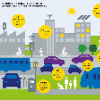Visual sensor networks are used for monitoring traffic in large cities and are promised to support automated driving in complex road segments. The pose of these sensors, i.e. position and orientation, directly determines the coverage of the driving environment, and the ability to detect and track objects navigating therein. Existing sensor pose optimisation methods either maximise the coverage of ground surfaces, or consider the visibility of target objects (e.g. cars) as binary variables, which fails to represent their degree of visibility. For example, such formulations fail in cluttered environments where multiple objects occlude each other. This paper proposes two novel sensor pose optimisation methods, one based on gradient-ascent and one using integer programming techniques, which maximise the visibility of multiple target objects. Both methods are based on a rendering engine that provides pixel-level visibility information about the target objects, and thus, can cope with occlusions in cluttered environments. The methods are evaluated in a complex driving environment and show improved visibility of target objects when compared to existing methods. Such methods can be used to guide the cost effective deployment of sensor networks in smart cities to improve the safety and efficiency of traffic monitoring systems.
翻译:这些传感器的构成,即位置和方向,直接决定驱动环境的覆盖范围,以及探测和跟踪在其中导航的物体的能力;现有传感器构成优化方法,要么使地面覆盖最大化,要么将目标物体(例如汽车)的可见度视为二进制变量,无法反映其可见度;例如,这些配方在多物体相互隐蔽的封闭环境中失灵;本文件提出两种新型传感器构成优化方法,一种基于梯度增益,一种使用整数编程技术,使多目标物体的可见度最大化;这两种方法都基于一种能提供像素水平目标物体可见度信息的发动机,从而能够应对在被污染环境中的隐蔽性;这种方法在复杂的驱动环境中进行评估,并显示目标物体与现有方法相比的可见度有所提高;这种方法可以用来指导智能城市传感器网络的成本有效部署,以提高监测系统的安全性和交通效率。





